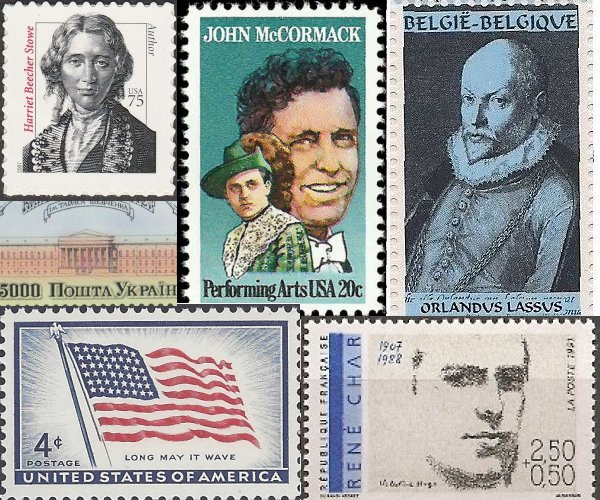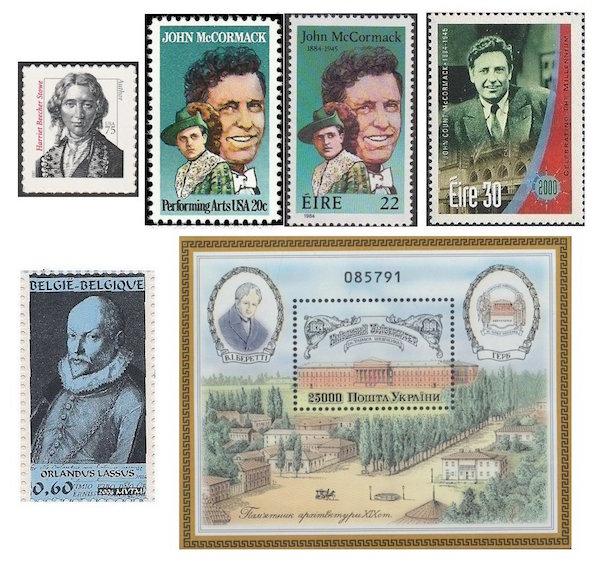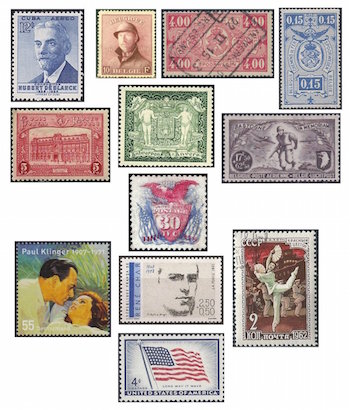The Arts on the Stamps of the World — June 14
An Arts Fuse regular feature: the arts on stamps of the world.

By Doug Briscoe
One would assume that Uncle Tom’s Cabin author Harriet Beecher Stowe (June 14, 1811 – July 1, 1896) would have been commemorated on a stamp long before the year 2007, but not so. She was born in Connecticut and moved at 21 to Cincinnati, where just three years earlier race riots between ethnic Irish and blacks had been motivated by fear of economic displacement. Stowe’s observations of the resulting injuries and injustices, stoked by further riots in 1836 and 1841, contributed to her growing indignation. She and her husband housed escaped slaves as a part of the Underground Railroad. Further, the loss of her infant son in 1850 brought home to her the helplessness of families separated on the auction block. The original subtitle of her famous book, which came out in 1852, was “The Man That Was a Thing”. She wrote many more books over the next forty-five years. (Curiously and inconsistently, she later defended in writing the cruel injustices of the Highland Clearances.) Stowe lived in Florida after the war, reporting no discourtesies from her neighbors, but late in life returned to Connecticut, where one of her Hartford neighbors was Mark Twain. She suffered from dementia toward the end, rewriting Uncle Tom’s Cabin as if it were new, and is buried in the cemetery at Phillips Academy.
The great Irish tenor John McCormack (1884 – 16 September 1945) was also born on June 14. The two stamps at center were issued jointly by the US and Ireland on June 6, 1984, in anticipation of the singer’s centenary. Later he was honored again by Ireland as part of an expansive series of stamp sheets marking the end of the Second Millennium. Note that he is there styled “John Count McCormack”—he was recognized in 1928 by Pope Pius XI as a Papal Count for his work for Catholic charities. This was in addition to his three papal knighthoods; he was also a Knight of Malta. He became a US citizen in 1917. Trivia: One of McCormack’s voice teachers was Vincenzo Sabatini, father of the adventure novelist Rafael Sabatini.

Also shown here is one of the greatest masters of the Renaissance, known variously as Orlandus Lassus, Roland (or Orlande) de Lassus, and Orlando di Lasso. No one knows even the year, never mind the day, of his birth (likely 1532), which took place in Mons (today Belgium), but he is featured here today because he died on the 14th of June, 1594. The story goes that he was kidnapped three times in childhood because of the beauty of his treble voice. At 12 he went to Italy, eventually taking positions at Naples and Rome, then moved to the court of Duke of Bavaria at Munich, where Lassus remained, justly famous and honored, for the rest of his life.
The Italian-born architect Vincent Beretti (14 June 1781 – 30 August [O.S. 18 August] 1842) grew up in Russia and studied in St. Petersburg from the age of 17. He was active in both Moscow and Kiev, where his greatest project was Saint Vladimir University (now Taras Shevchenko University), loosely known as the “Red Building“. It and Beretti’s portrait are shown on the souvenir sheet. The work was begun in 1837 and completed by Beretti’s son Alexander in 1843. Another prominent structure by Beretti is the former Institute for Noble Maidens, a boarding school that was known as the October Palace from its restoration in the 1950s until the fall of Communism period, when it was renamed the International Center for Culture and Arts.
Dutch pianist Hubert de Blanck, born this day in 1856, concertized to great acclaim in Europe and then the Americas, where he met and married the cousin of Mario García Menocal, a future president of Cuba. De Blanck emigrated to that country in 1883, created the first Cuban conservatory of music, and died and was buried in Havana in 1932.

Jean De Bast (1883 – 24 December 1975) spent almost his entire professional life as an engraver of Belgian postage stamps. His first work in the field was for the 1919 definitive series of a helmeted King Albert. Over the next half century he engraved more than a hundred stamps along with several of the commonly seen (well, if you’re a stamp collector) designs for use by the Belgian Railways (two examples shown, plus one, less common, showing the Central Post Office). Two more: in 1930 he executed the engraving for a stamp promoting that year’s philatelic exhibition in Antwerp, and 1946 saw the issuance of a stamp with a surcharge to create a memorial for Americans killed in the Battle of Bastogne (the original drawing was by one S. André).
Having mentioned a tribute to the United States, I would be remiss to ignore Flag Day, which was proclaimed by President Wilson 101 years ago, though it is not an official federal holiday. The first US stamp to display the flag in any way was the 1869 Shield and Eagle; the first to show it alone came out in—did you guess it was during the Cold War?—1957!
Paul Klinger (born Klinksik, 14 June 1907 – 14 November 1971) wanted to be an actor, but daddy said no and sent him packing to learn architecture. When daddy died and left Paul unable to pay his tuition, the young fellow had no choice, he simply had to turn to acting. He began on the stage and made his first film in 1933. He worked through the war years in both film and radio but reached the height of his popularity in the 50s, when he was also very busy dubbing the voices of Cary Grant, Humphrey Bogart, Bing Crosby, Tyrone Power, Jean Gabin, and many more. In the 60s he had a successful television career.
Born on exactly the same day was French poet René Char (14 June 1907 – 19 February 1988). He saw the publication of his first volume of poetry, Cloches sur le cœur in 1928. He served in the French Resistance as a commander during World War II. Some of Char’s works were translated into English by William Carlos Williams and Samuel Beckett. His personal friends included Picasso, Miró, and Camus; if not for the fact that there wasn’t enough room for him in the car, he would have been in the crash that killed Camus. One of the works central to the output of Pierre Boulez, Le Marteau sans maître, is set to Char’s poetry, as are two earlier Boulez compositions, Le Visage nuptial and Le Soleil des eaux.
The Red Poppy is particularly famous for its “Russian Sailors’ Dance“. The complete ballet was first heard on 14 June 1927 in the Bolshoi Theater under the direction of Yuri Fayer. By the following year it had received a hundred performances. The stamp is one of four issued by the USSR in 1961 and 1962 to honor the Russian Ballet.
I suspect that American photographer Margaret Bourke-White (June 14, 1904 – August 27, 1971) will have her day in philatelic court. Of Jerzy Kosinski (Józef Lewinkopf, June 14, 1933 – May 3, 1991) I’m less optimistic. And happy birthday to British author Peter Mayle (born 14 June 1939).
A graduate of the University of Massachusetts with a B.A. in English, Doug Briscoe worked in Boston classical music radio, at WCRB, WGBH, and WBUR, for about 25 years, beginning in 1977. He has the curious distinction of having succeeded Robert J. Lurtsema twice, first as host of WGBH’s weekday morning classical music program in 1993, then as host of the weekend program when Robert J.’s health failed in 2000. Doug also wrote liner notes for several of the late Gunther Schuller’s GM Recordings releases as well as program notes for the Boston Classical Orchestra. For the past few years he’s been posting a Facebook “blog” of classical music on stamps of the world, which has now been expanded to encompass all the arts for The Arts Fuse.
